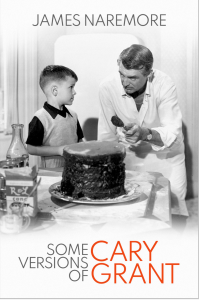



This week, Jeff Godsil revisits George Cukor's Holiday, from 1938, with Cary Grant and Katharine Hepburn, and Matthew of KBOO's bedtime story program Gremlin Time looks at Juggernaut, while in the book nook, we scrutinize two new books that explore the screen craft of Cary Grant.
-----------------------------------------------------------------
[Typos will be corrected shortly.]
James Naremore is one of the most important of America’s film writers who came of age in the ’70s. An Indiana professor emeritus, he has written books on Psycho, Vincente Minnelli, Kubrick, an important volume on film noir, adaptation, among others, as well as acting for the screen, to which his new book, Some Versions of Cary Grant, from Oxford University Press, offers a detailed companion. It’s not a biography, but rather a critical account of just what it is Cary Grant does on screen.
After an introductory set of principals and background on Grant as a person and screen presence, the author posits the six kinds of Cary Grant we see on the screen, while discussing his contributions to 12 films.
The first is farceur Grant, in the films The Awful Truth, Bringing Up Baby, and His Girl Friday. The second category is Dark grant, in the Hitchcock films Suspicion and Notorious. Romantic Cary focuses on An Affair to Remember and Indiscreet, while Domestic Grant appears in Mr. Blandings Builds his Dream House, and Room for One More. Finally, Cockney Cary appears in Sylvia Scarlett and None But the Lonely Heart.
Those who find this book intriguing are encouraged to first look up the Cary Grant chapter in his earlier Acting in the Cinema, where he covers the Grant films North by Northwest and xxxx. Taken together that chapter and this brief book comes to about 225 pages.
There are several other Cary Grant books, but this is the best from an analytic angle. There are about four massive biographies on the actor that to varying degrees go into his private life, and one memoir by an ex-wife, and another by their daughter. There are two previous critical assessments of Grant, one novella length by Pauline Kael in The New Yorker, wherein the writer as is her won’t starts out admiring Grant’s skill but then half-way in, turns on him and bemoans his lack of ambition, or something. The other is an ambitious book by the late Andrew Britton, which interprets grant’s career within the context, to riot in imprecision, of a heteronormative commercial film industry. He wrote and equally instructive volume on Katharine Hepburn. Anyway, to give the flavor of the prose here are some passages from the book’s opening:
“Any study of a performance by a star needs to deal with the relationship between an actor (a performer with a range of physical traits and technical skills, some inherent, others developed, which result in a personal style), a role (a fictional character with physical and personality traits the actor must embody), and a kind of aura or star image (an intertextual phenomenon determined by publicity and performances, influencing the kinds of roles the actor plays).4 Besides all this, the star is a social subject whose life history can become public, affecting the performances, roles, and image.”
Later he expands:
“The expressions themselves can be more or less conventional. Theatrical performance in the past two hundred years originates with what historians call a “mimetic” or “pantomime” tradition of codified expressions and gestures, which actors learned to imitate; but in the twentieth century, except in the avant-garde, it moved increasingly toward improvisation, realism, and naturalism. (Improvisation on the stage is, of course, different from improvisation in movies because film scenes can be reshot.) In the late nineteenth century, playwright William Archer’s Masks or Faces argued that actors should never imitate emotions: “We weep our own tears, we laugh our own laughter.”17 Be that as it may, Hollywood movie actors in the interwar years were still using fairly conventional (if less flamboyant) poses and facial expressions to indicate grief, joy, puzzlement, fear, confusion, and so on. The best of these actors, however, developed a physical and emotional idiolect. In Grant’s comedies, for example, we encounter not only the distinctive Grant enunciation but also the Grant mumble, the Grant whinny, the Grant crouch, the Grant double-take, the Grant tendency to bite his lower lip in teasing fashion after making a joke, and the Grant habit of rubbing his hands together in satisfaction.”
That pretty much nails down all of Grant’s tricks of performance, and good luck not noticing them the next time you take in a Grant comedy.
Finally, he writes a stirring defense of Grant’s kind of approach to the screen:
“As I’ve indicated, the star’s image is always an oversimplification. Moreover, it can obscure the talent needed for its creation. In Grant’s case the image was so powerful that he was sometimes treated with condescension, as if he were simply a charming fellow who always played the same thing. Katharine Hepburn said that Grant was “a personality functioning . . . He can’t play a serious part or, let me say, the public isn’t interested in him that way . . . But he has a lovely sense of timing, an amusing face and a lovely voice.”10 Pauline Kael wrote that Grant was “a wonderful object of contemplation,” who “might have become a great actor” if he had “taken more risks.”11 Remarks such as these, based on the fallacious assumption that the star’s image requires no work and that Grant’s performances in a gallery of great films lacked variety or seriousness, should be dismissed out of hand. Hepburn was correct that Grant was a “personality functioning” (so was she), but this simply means that he was expert at what in an earlier era was called “personality acting,” or the creation of attractive or distinguishing traits that can recur across roles. At a specialized or meta level, Grant was a supremely successful example of something we all do in everyday life, which is why the metaphor of life as theater is so common, and why some people may have thought Grant wasn’t acting.”
All the chapters are refreshingly rich in details and ideas. One that I found to be too relying on plot summary was Mr. Blandings Builds His Dream House, a not very happy comedy, and Mr Naremore also seems unenthusiastic about the film until he focuses on the film’s so-to-speak “incoherence,” and makes it slightly more interesting in retrospect than it is in the viewing. Others, If you want to learn how actors act, this is a good place to start.
–––––––––––––––––––––––––––––––––––-
The other Carrie Grant book under examination is Cary Grant’s Suit, by Todd McEwan, and published by Nottinghill Editions, a firm that publishes short and interesting and eccentric nonfiction. Mr. McEwan is was born in Southern California in the 1950s. As a child he was interested in comedy and the undersea realm, and terrified by Bambi. In high school he had his own radio show, interviewing folk singers and puzzle inventors. At university he read Victorian and medieval English literature. He worked in radio, theatre and the rare books trade before arriving in Scotland in the 1980s. After a spell at Granta, he has often worked as an editor and teacher. His novels include Fisher’s Hornpipe, McX: A Romance of the Dour, Who Sleeps with Katz and The Five Simple Machines.”
Subtitled, “Nine Movies that Made Me
the Wreck I Am Today,” Cary Grant's suit is a very funny collection of essays on our relationship with movies. In fact, only the last chapter has anything to do with Cary Grant. Other chapters include SAN memoirs on technicolor, 20,000 leagues under the sea, 50s sci-fi, films, and an hilarious chapter about a lifelong obsession with Chinatown, which I'd like to talk about, but it would throw us off the rails. Instead, he adopts the conceit that north by Northwest is really about the adventures of the suit worn by Carrie Grant. For example, he writes at the beginning:
“North by Northwest isn’t about what happens to Cary Grant, it’s about what happens to his suit. The suit has the adventures, a gorgeous New York suit threading its way through America. The title sequence in which the stark lines of a Madison Avenue office building are ‘woven’ together could be the construction of Cary in his suit right there – he gets knitted into his suit before his adventure can begin. Indeed some of the popular ‘suitings’ of that time, ‘windowpane’ or ‘glen plaid’, reflected, even perfectly complemented office buildings. Cary’s suit reflects New York, identifies him as a thrusting exec, but also protects him, what else is a suit for? Reflects and Protects … a slogan Roger Thornhill himself might have come up with.”
Furthermore, he writes:
“ They bundle him into a limousine and shoot out to Long Island, not much manhandling yet. In fact Martin Landau is impressed: ‘He’s a well-tailored one, isn’t he?’ He loves this
suit.
“His suit is like a mouse victim of repeated cartoon violence – in the next shot it’s always fine.”
Mr. McEwan does have a thesis of search about what the film "means," which is summed up as the following:
“You get the creeps and realize this whole thing is about insecurity, exposure, clothing anxiety. When Cary escapes out to the window ledge he’s inching his way along in a pair of brand new slip-ons which may not fit! Your feet and hands start to sweat at this moment and they don’t stop. But make no mistake: Cary is now in black and white: everything is CLEAR to him, and he acts decisively OUTSIDE the suit, in order to be able to win it back. For us there’s the confusion and disgrace of a badly-dressed Cary: the situation is now a real emergency.
Now he crawls up the stone wall of James Mason’s millionaire’s hideaway, which looks so like the face of the office building in the beginning, the rectangles of a snazzy suit. And in this white shirt with no jacket, Cary is a sitting duck in the bright moonlight! A New Yorker without a jacket on. It is too frightening.”
This whole brief book is tongue-in-cheek, hilarious, insightful, and definitely makes you want to watch again the movies he discusses, having seen by himself, and with his friends.
- KBOO


